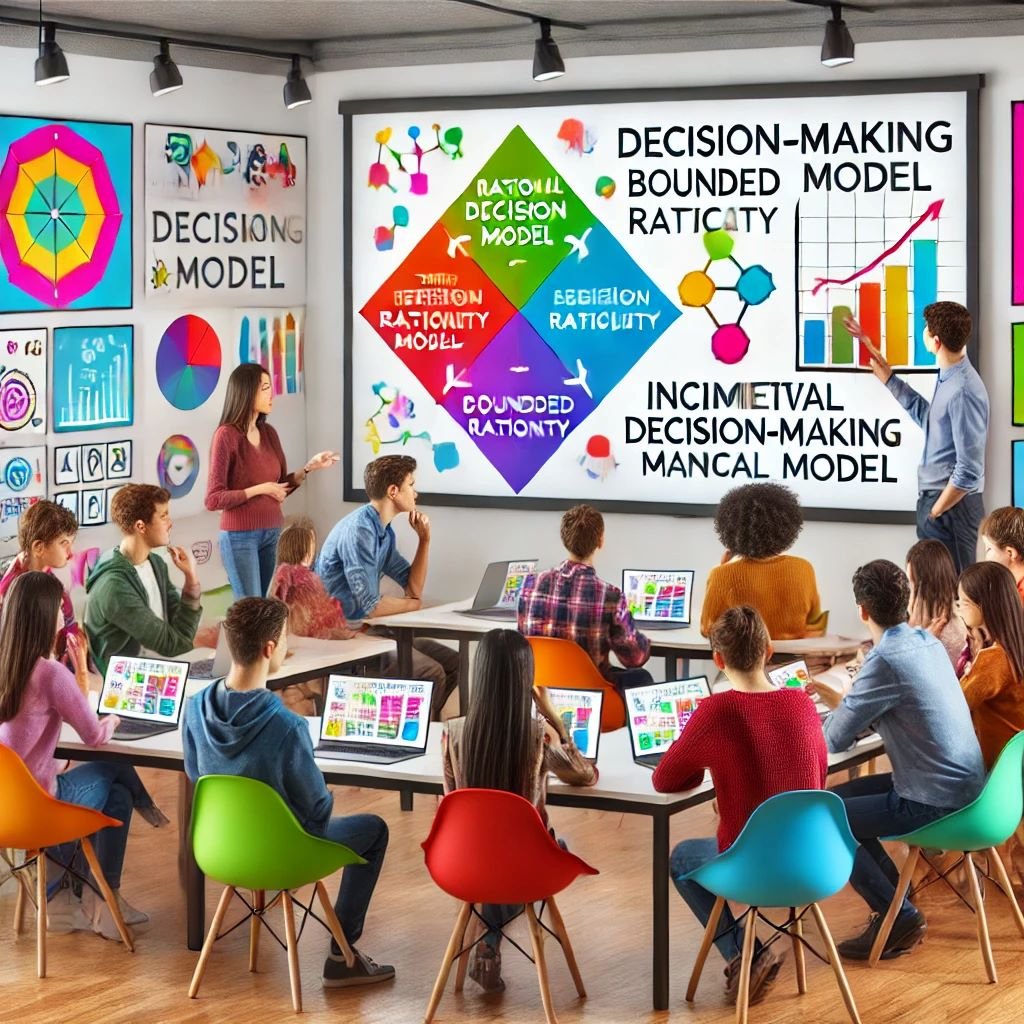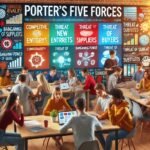
Week 3: Decision-Making Models and Frameworks
Lesson Overview
This lesson will provide an in-depth exploration of various decision-making models and frameworks.
Students will learn about the rational decision-making model, bounded rationality and satisficing, the incremental decision-making model, and the garbage can model of decision making.
The goal is to understand the strengths and limitations of each model and how they can be applied in different business contexts.
Learning Objectives
By the end of this lesson, students will be able to:
- Understand and describe the rational decision-making model and its application.
- Explain the concept of bounded rationality and the satisficing approach.
- Understand the incremental decision-making model and its relevance in business.
- Describe the garbage can model of decision making and identify situations where it might be applicable.
- Compare and contrast these models and frameworks, and apply them to real-world scenarios.
Key Concepts and Terminology
- Rational Decision-Making Model: A systematic process of defining problems, evaluating alternatives, and choosing the best solution.
- Bounded Rationality: The idea that decision-makers are limited by information, cognitive limitations, and time constraints.
- Satisficing: A decision-making strategy that aims for a satisfactory or “good enough” solution rather than the optimal one.
- Incremental Decision-Making Model: A model that suggests decisions are made through small, incremental changes rather than big leaps.
- Garbage Can Model: A model that describes decision making in organizations as a chaotic process where problems, solutions, and participants randomly collide.
Lesson Content
1. Introduction to Decision-Making Models and Frameworks
Definition and Importance:
- Decision-making models and frameworks provide structured approaches to making decisions.
- They help in systematically analyzing problems and evaluating alternatives.
Discussion:
- Briefly discuss the various contexts in which different decision-making models might be used.
- Encourage students to share their experiences with decision-making processes in their personal or professional lives.
2. Rational Decision-Making Model
Overview:
- The rational decision-making model is a structured and systematic approach to problem-solving.
- It involves a step-by-step process to ensure logical and thorough decision making.
Steps in the Rational Decision-Making Model:
- Identify the Problem: Clearly define the problem that needs to be solved.
- Gather Information: Collect relevant data and information to understand the problem fully.
- Generate Alternatives: Brainstorm possible solutions to the problem.
- Evaluate Alternatives: Assess each alternative based on criteria such as feasibility, risk, and impact.
- Choose the Best Alternative: Select the solution that best addresses the problem.
- Implement the Decision: Put the chosen solution into action.
- Evaluate the Decision: Monitor the implementation and make adjustments if necessary.
Strengths and Limitations:
- Strengths: Provides a clear and logical framework, reduces bias, and promotes thorough analysis.
- Limitations: Assumes availability of complete information, can be time-consuming, and may not be suitable for complex, dynamic environments.
Case Study:
- Present a case study where the rational decision-making model was applied successfully. Discuss the steps taken and the outcomes achieved.
Activity:
- Students work in groups to apply the rational decision-making model to a hypothetical business problem.
3. Bounded Rationality and Satisficing
Bounded Rationality:
- Introduced by Herbert A. Simon, bounded rationality acknowledges the limitations in decision-making processes due to constraints on information, cognitive capacity, and time.
- Decision-makers aim to make rational choices within these limitations.
Satisficing:
- Satisficing is a strategy where decision-makers seek a satisfactory solution rather than the optimal one.
- This approach is practical when time and resources are limited.
Examples:
- Provide examples of situations where bounded rationality and satisficing are applied, such as in hiring decisions or consumer choices.
Discussion:
- Compare and contrast bounded rationality with the rational decision-making model.
- Discuss the implications of satisficing in business decisions.
Activity:
- Students individually identify a decision they have made using satisficing and share their experiences with the class.
4. Incremental Decision-Making Model
Overview:
- The incremental decision-making model suggests that decisions are made through small, incremental steps rather than large, comprehensive changes.
- This model is often used in public policy and organizational change.
Process:
- Decisions are made by building on previous steps, making small adjustments and improvements.
- This approach allows for flexibility and continuous improvement.
Strengths and Limitations:
- Strengths: Allows for adaptability, reduces risk, and is more manageable in complex situations.
- Limitations: Can lead to slow progress, may overlook innovative solutions, and can perpetuate the status quo.
Case Study:
- Present a case study illustrating the use of the incremental decision-making model in a business or policy context.
Activity:
- Students work in groups to develop a plan for incremental changes in a business scenario, such as improving customer service or product development.
5. Garbage Can Model of Decision Making
Overview:
- The garbage can model, developed by Cohen, March, and Olsen, describes decision making in organizations as a chaotic process where problems, solutions, participants, and choices randomly interact.
- This model is particularly relevant in complex, ambiguous, and dynamic environments.
Key Concepts:
- Problems, solutions, participants, and decision opportunities are seen as separate streams that flow within an organization.
- Decisions are made when these streams randomly converge.
Examples:
- Provide examples of organizations or situations where the garbage can model might apply, such as startups or crisis management scenarios.
Strengths and Limitations:
- Strengths: Reflects the reality of decision making in complex environments, highlights the role of chance and timing.
- Limitations: Lacks structure, can be unpredictable, and may lead to suboptimal decisions.
Discussion:
- Discuss the practical implications of the garbage can model and how it differs from more structured models.
Activity:
- Students analyze a chaotic decision-making scenario and identify how the garbage can model applies.
6. Comparing and Contrasting Decision-Making Models
Summary:
- Recap the key features, strengths, and limitations of each decision-making model.
- Rational decision-making model: Structured and logical, but time-consuming.
- Bounded rationality and satisficing: Practical under constraints, but may settle for less optimal solutions.
- Incremental decision-making model: Flexible and adaptive, but slow and conservative.
- Garbage can model: Reflects real-world chaos, but unpredictable.
Activity:
- Group discussion and comparison of the models, focusing on their applicability in different business scenarios.
Application:
- Students select a real-world business problem and determine which decision-making model would be most appropriate to apply and why.
7. Conclusion and Takeaways
Summary:
- Highlight the importance of understanding different decision-making models and frameworks.
- Emphasize the need to choose the appropriate model based on the specific context and constraints of the decision-making situation.
Reflection:
- Encourage students to reflect on their learning and consider how they can apply these models in their future professional roles.
Next Steps:
- Assign readings and case studies for further exploration of decision-making models.
- Prepare for the next lesson, which will delve into tools for strategic decision making, such as SWOT and PESTEL analysis.
Additional Resources
Readings:
- “Decision Making and Problem Solving” by Herbert A. Simon
- “The Art of Strategic Decision Making” by Peter Hollins
- “Organizational Decision Making” by Zur Shapira
Tools:
- Decision Matrix Templates
- Mind Mapping Software for Brainstorming Alternatives
Online Resources:
- Harvard Business Review articles on decision-making strategies
- TED Talks on decision making and cognitive biases
Instructor Notes
- Preparation: Ensure availability of case studies and materials for group activities.
- Engagement: Foster active participation and encourage sharing of personal experiences to enrich discussions.
- Follow-Up: Plan follow-up activities to reinforce the application of decision-making models in real-world scenarios.
















